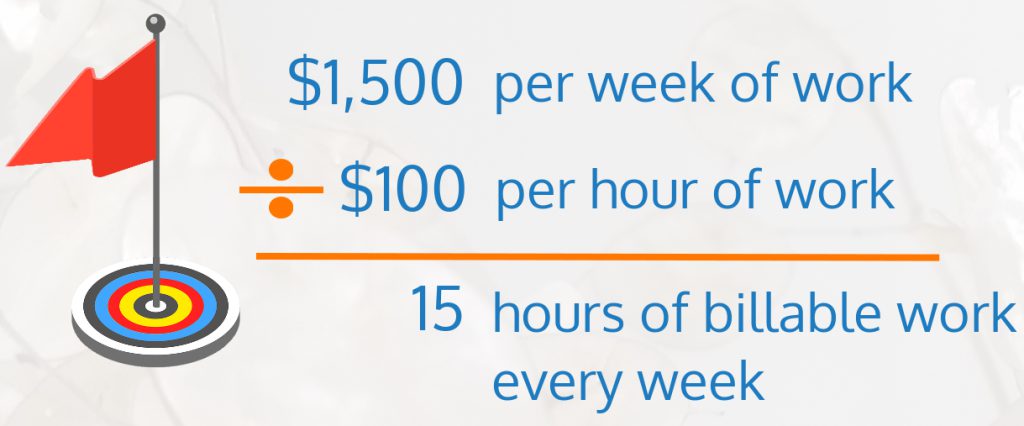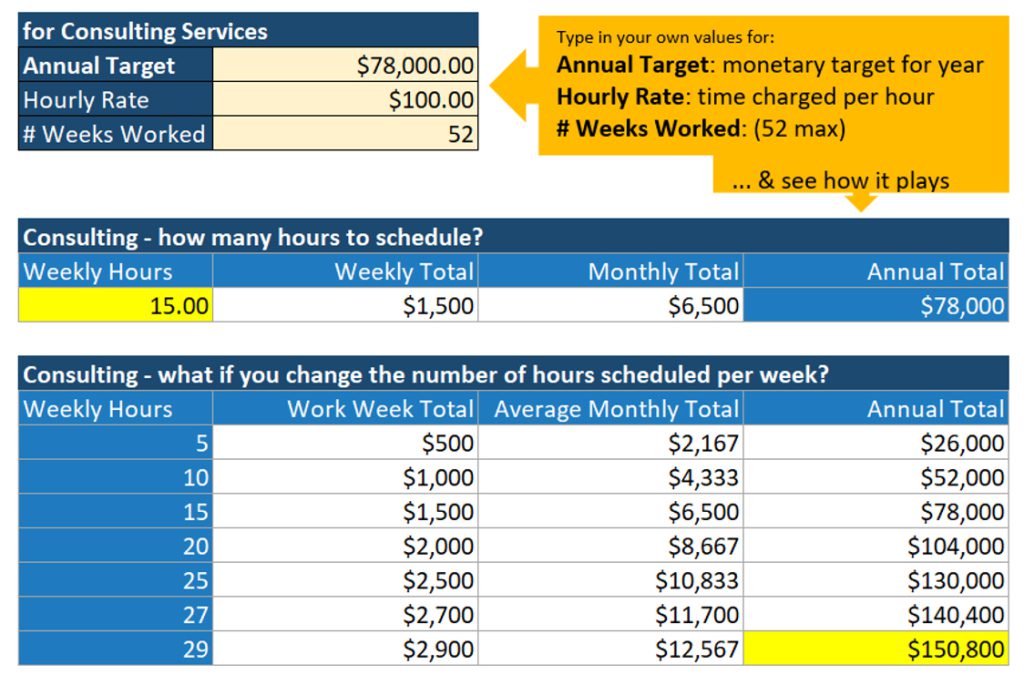Vision to Action: Turning ideas into actionable and measurable steps
It can be hard to figure out how to turn big picture ideas and goals into actionable and trackable steps. For many things, the “figuring out” lies in a mixture of clarity, and then reframing and rephrasing. Here we take a monetary target and some other information from a business model, and turn it into something that’s doable, measurable, and actionable. If you’re stuck at this part of the process, this post might help.
Lay the foundation for strategy and metrics
To get the strategy and metrics parts in place, you need to define your terms in a way that will help you, or others on your team, think about this part of the vision in a way that helps you set a course and, as needed, correct your course.
Clarity
Let’s start with clarity. For this example, we’ll set our monetary target at $78,000, which we’ll assume covers overhead and operational costs, and also gives us the take home pay we want for the year. In a lot of ways, $78,000 is a yes or no type of target – you hit the target, or you don’t. It’s a clear target, but it’s nebulous in terms of strategy and metrics. Even knowing how close or far away you are from hitting the target doesn’t tell you what to do about it.
You need more information, which you can pull from your business model. For this example, let’s say you run a service-based business, and you charge based on time spent with your clients, at a rate of $100 per hour. Let’s also say that you plan to work with clients all 52 weeks of the year. Now you have the beginning of a measurable goal:
In a given timeframe, all 52 weeks of the year, sell your services to clients at a rate of $100 per hour, so that you reach the goal of $78,000 by the end of the year.
Time for Reframing and Rephrasing
To make this more actionable, this is where you start reframing and rephrasing the goal.
If you do a little math, that is, dividing your $78,000 target for the year by the number of weeks you plan to work in the year, you have a new goal of $1500 per week. You’ve just reframed the timeframe. That’s still a little nebulous, but it’s a little more trackable for metrics – it’s now as yes or no target per week instead of a yes or no target for the entire year. You’ll be able to check, every week, how you’re progressing towards the goal for the year. So, you’re on the right track, but you’ll want to reframe or rephrase again.

Going back to how much you charge, that is, $100 per hour, you can take that $1500 per week and reframe it as 15 hours of billable time per week. That is, you’ve reframed in terms of billable hours required instead of just time.

Now you have a new way of talking about this goal that’s action focused:
In order to meet your target of $78,000 per year, you need to schedule 15 hours of billable time per calendar week.
That’s barely even a part time job’s worth of work! It’s doable, measurable, and actionable.
Use a Calendar to Track Your Efforts
When looking at your calendar….

If you’ve scheduled more than 15 hours for a week, excellent! That will help you buffer for leaner times.
If you’ve scheduled exactly your 15 hours for a week, then you know you’re at least on track for your target.
If you have not scheduled 15 hours for a week, what can you do to get those hours on the books? You’ll need to look to your specific client funnels and tactics for this.
Whatever the case, the benefit of thinking in terms of scheduling billable hours instead of just targeting $78,000 by the end of the year, is that you at least have a starting place for taking action towards that $78,000 instead of just hoping for the best.
Use a Model to Consider Your Options
Now, while data is clues and not facts, and it’s impossible to account for all of the variables in any business situation, it can be helpful to use a model, a simplified approximation, while you play around with numbers and consider your options and your targets. Having the vision reframed and rephrased, and having a model in place, means that, if your goal changes, or the individual parts change, or life happens, you have a starting point for seeing how that might affect the end result, and how you might need to course correct as a result. You can adjust your annual target or your rate of pay and see how that impacts how many hours to schedule. And you can extend this model to packaged service offerings and monthly retainers instead of just hourly rates.

I’ll caveat that this is a really simplified version of turning vision into insight and action. Business comes in ebbs and flows, and sometimes seasons, which are not accounted for in this preliminary model. Nor does it account for having a variety of services or products, but this should give you a good starting point for thinking about action and metrics.
Your Turn – So What? Now What?
As you look to your own vision statement, and start performing this reframing and rephrasing exercise on the individual components, how do you know if you’re on the right track for clarity, reframing, and rephrasing? There’s a phrase you can keep in mind: So What? Now What?
“So what?” helps you stay focused on the things that are really important. You should be able to answer this question in the form of “This is important because…” and that justifies your time and effort in tracking this part, because it’s so easy to become “data rich and information poor (DRIP).”
“Now what?” helps you stay focused on keeping this as actionable as possible. Information is nice to have, but, if it doesn’t help you figure out if you’re on the right track for a goal, then it’s interesting trivia, not a business metric. If this is working, can you do more of it? Should you stay the course? If it’s not working, can you revise your tactics, or should you just refocus your efforts elsewhere?
I’ll also caveat that it’s easier to apply this reframing and rephrasing process with some parts of your vision than others, and some parts of your vision simply cannot and should not be broken down in this way.
Get a Copy of The Vision-to-Action Model
If you’ve never modeled before, or you’re curious about how this model is set up, you can get a copy of the Vision to Action spreadsheet from our Gumroad site.





